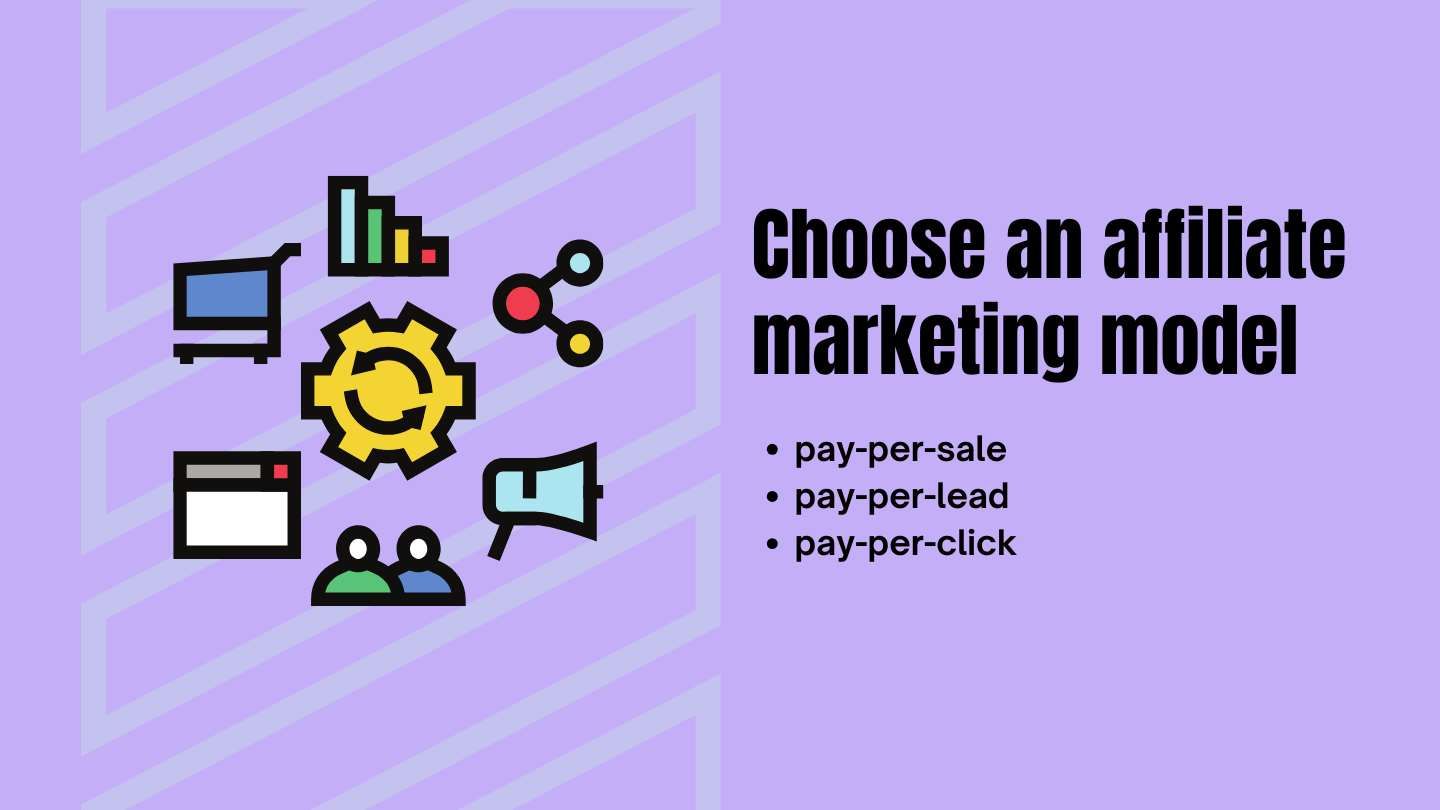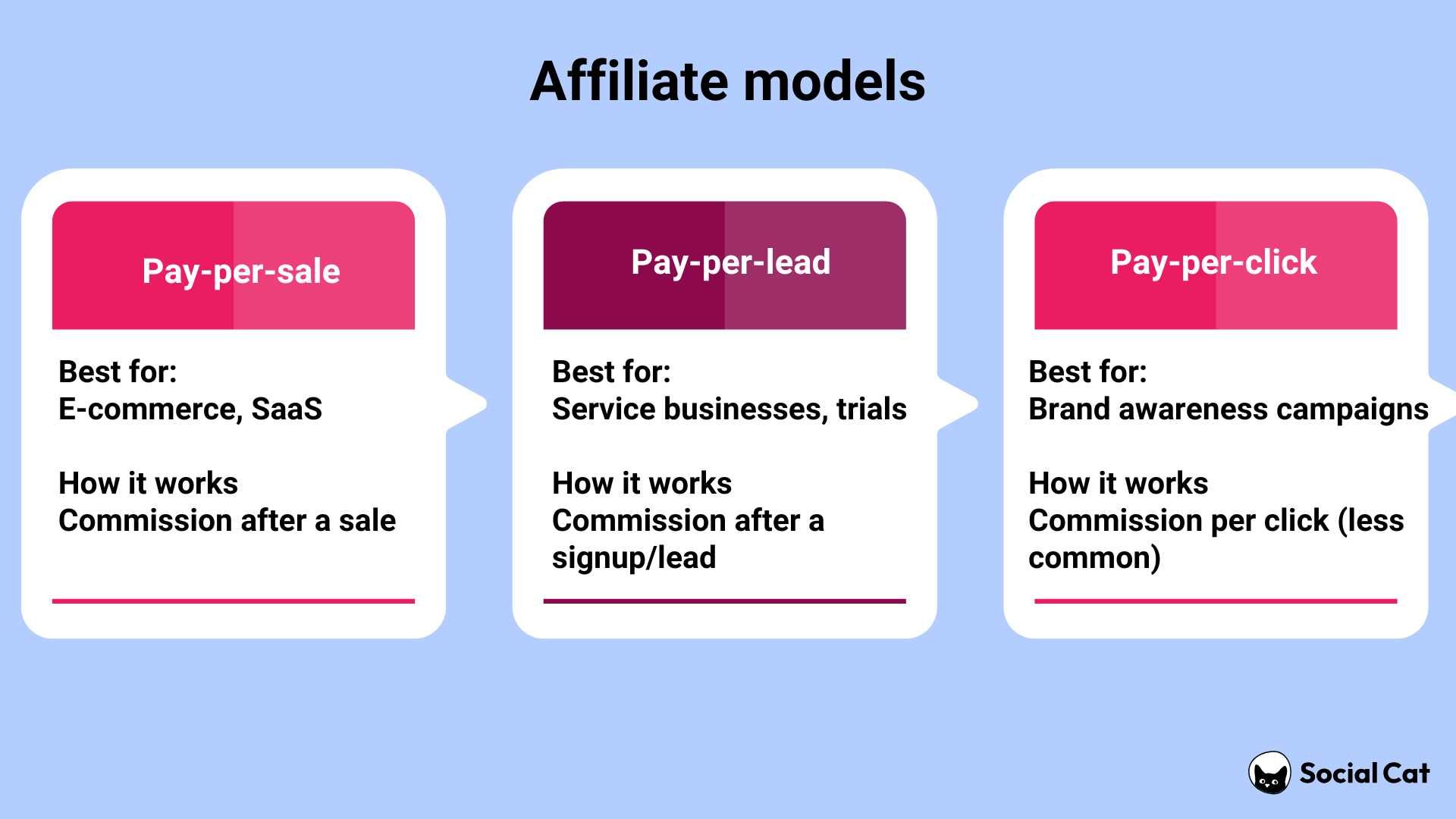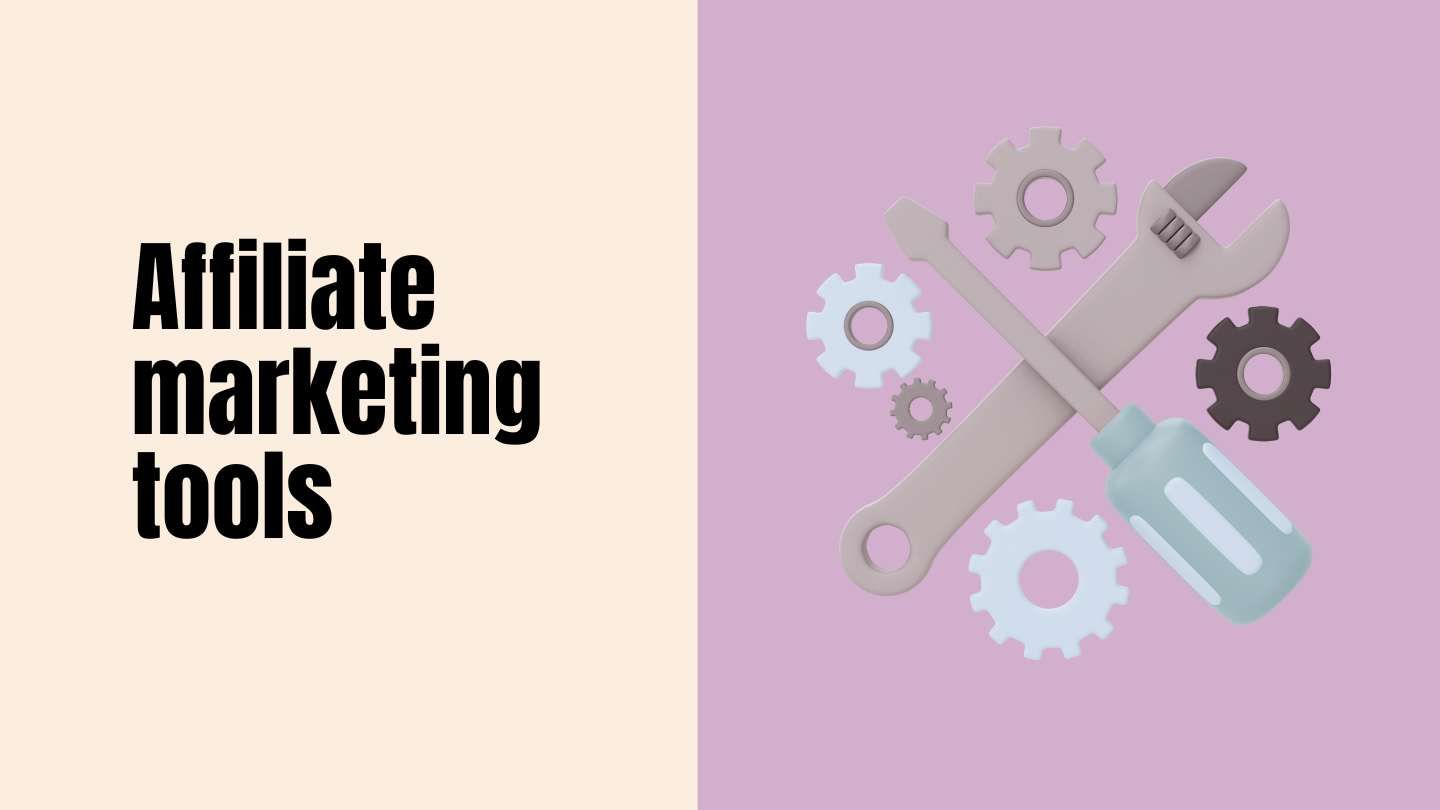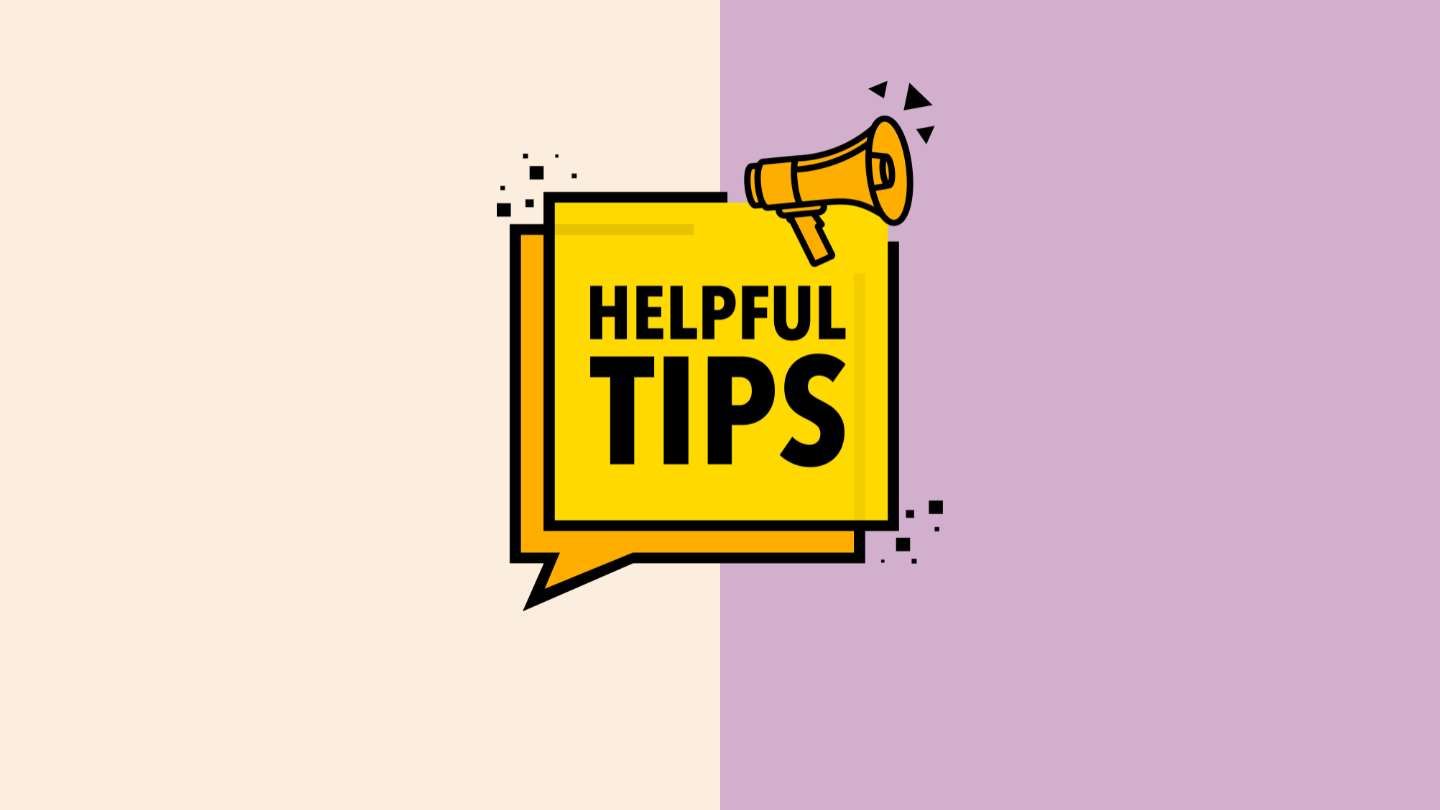Affiliate marketing isn’t just some internet trend, it’s one of the most practical ways to grow your business without overspending on ads. Instead of pouring your budget into Facebook or Google, you work with partners who promote your product. You only pay when you get real results. Simple, right?
In this guide, we’ll show you how to build an affiliate marketing program that actually works. And most importantly, we’ll help you answer questions like:
- How do I set goals that are actually useful, not just “get more sales”?
- Which affiliate model fits my product best?
- What tools will help me scale without getting overwhelmed?
- Where do I find the right affiliates, and how do I keep them engaged?
- What kind of support or content should I give affiliates to help them succeed?
If you’ve been wondering how to launch an affiliate program the right way, this guide is for you.
1. Set a goal that actually helps you grow

Before you even think about setting up links or inviting affiliates, take a step back and ask yourself: What exactly do I want this affiliate program to do for my business?
It sounds obvious, but many businesses skip this part. They jump in thinking, “Affiliate marketing is hot, we need to do it too,” without defining what success actually looks like. That’s how you end up with a program that’s live but not doing much.
Your goal doesn’t need to be complicated. In fact, it shouldn’t be. Think in terms of one or two specific outcomes. Do you want to:
- Get more product sales?
- Grow your email list or trial signups?
- Raise awareness with a niche audience you can’t easily reach through ads?
Let’s say you run a skincare brand. Your goal might be to get 500 new customers in the next 3 months through affiliate links. That’s not just a vague hope, it’s a clear target. You can measure it. You can report on it. And most importantly, it gives you direction for everything that comes next, from who you recruit to how you track success.
And don’t forget: the more specific your goal, the easier it is to improve later. If you know that 70% of affiliate sales came from Instagram creators, for example, you’ll know where to focus your time next quarter.
So before you launch anything, get clear on what matters most. Because if you don’t know what you’re aiming for, how will you know when it’s working?
2. Choose a model that fits how you sell

Once you’ve set your goal, it’s time to figure out how you’re going to reward the people helping you reach it. That means choosing the right affiliate payment model.
There’s no one-size-fits-all here. The best model depends on your product, your margins, and what kind of actions matter most to your business.
Pay-per-sale
For most e-commerce and SaaS brands, pay-per-sale is the obvious starting point. It’s simple: you pay a percentage or a flat fee for every sale an affiliate brings in. No sale, no payout. Everyone wins only when revenue comes in, and that’s a big reason why this model is so popular.
Pay-per-lead
But not every business is selling a product right away. If your focus is on generating leads, say you’re running a software trial, a service business, or a newsletter, pay-per-lead might make more sense. In this model, you reward affiliates when someone fills out a form, signs up for a trial, or takes some other step toward becoming a customer. It’s a little more front-loaded on your end, but it works well when your actual sale happens later.
Pay-per-click
And then there’s pay-per-click. It’s less common, mostly because it comes with more risk. You’re paying for traffic, not outcomes. But if your goal is brand awareness or site visits (rather than direct sales), this model can work, especially with tightly monitored campaigns.
Here’s a practical tip: if you run a subscription-based business, think about offering recurring commissions. Instead of paying just once for a signup, you give affiliates a percentage every month that user stays subscribed. It keeps your partners motivated to bring in high-quality, long-term users. Tools like FirstPromoter make this easy to manage.
So, don’t rush this step. Choose a model that matches your goals and how your business actually works. The more your incentives align with your affiliates’ efforts, the more likely you are to build a program that performs.

3. Pick a tool that keeps things organized

If you’re trying to manage your affiliate program using spreadsheets and email threads, you’re setting yourself up for chaos. It might work when you have one or two partners, but once you start growing, things get messy fast.
Imagine trying to track dozens of unique referral links, calculate commissions manually, send payments one by one, and respond to every affiliate asking, “Did I earn anything this month?” That’s not scalable, and it definitely won’t help you grow.
That’s why a dedicated affiliate management tool isn’t optional. It’s essential.
These tools handle the heavy lifting for you: tracking who sent what traffic, calculating commissions automatically, and giving your affiliates a dashboard where they can see everything without needing to message you.
So which tool should you choose? It depends on what kind of business you run.
If you’re running an online store on Shopify, Refersion is a solid pick. It plugs right into your store, so setting up tracking is fast and doesn’t require a developer. You can easily approve new affiliates, manage payouts, and even create promo codes for influencers.
Running a SaaS product with recurring revenue? Check out FirstPromoter. It’s made for companies that want to offer monthly commissions, and it connects directly with tools like Stripe. That means affiliates can earn every month their referral stays subscribed, and you don’t have to lift a finger.
Need something more flexible? Tapfiliate is a beginner-friendly platform that works with all kinds of setups, ecommerce, SaaS, or service-based businesses. It gives you solid tracking and automation without needing a complicated setup.
No matter what you choose, make sure it’s:
- Easy for affiliates to join and start promoting
- Reliable when it comes to tracking clicks and sales
- Automated enough to handle payouts without stress
- Transparent, so both you and your affiliates can see what’s going on
And one last tip: don’t just go for the cheapest option. Go for the one that fits how your business runs. A tool that saves you time, keeps your partners happy, and grows with you is worth way more than one that just looks affordable on paper.
Check our affiliate tool reviews, as it might help choose the right partner.
4. Write affiliate terms everyone understands

Think of your affiliate terms as the ground rules of the partnership. If they’re too vague or packed with jargon, you’re going to end up answering the same questions over and over or worse, cleaning up after misunderstandings that could’ve been avoided.
You don’t need to write a full legal document, but you do need to be clear. What does the affiliate get? What do you expect from them in return?
Start with the basics. Explain how affiliates will earn money. Will they get 15% of every sale they refer? A flat $10 per order? Be specific.
Next, let them know how long their referral stays valid. This is called the “cookie window.” If someone clicks their link but doesn’t buy right away, how long do they still get credit? Common windows are 30 or 60 days, just make sure it matches your sales cycle.
Then, talk about payments. When and how will they get paid? Many programs run monthly payouts, but some hold payments for 15 or 30 days to account for refunds or returns. Whatever your process is, lay it out.
Finally, give a few clear dos and don’ts when it comes to promotion. Can affiliates run ads with your brand name? What about email lists or coupon sites? Set boundaries, but keep it friendly, your goal is to build trust, not scare people off.
Here’s a tip: write your terms like a simple FAQ, not a wall of legal text. The easier they are to understand, the easier it is for someone to say “yes” and start promoting your brand the right way.
We’ll end this paragraph with an affiliate terms template
example:
🤝 Welcome to our affiliate program! Here’s how it works:💰 Commission:
You’ll earn 15% on every sale you refer. No caps. No minimums. Just sales = earnings.
🕒 Cookie window:
If someone clicks your link, you’ll get credit for any purchase they make within 30 days.
💵 Payouts:
We send payments via [PayPal/Stripe] once a month, with a 15-day hold to account for returns or cancellations.
📢 Promotion Guidelines:
You’re free to share your link however you like, social posts, blogs, emails, etc. Just a few rules:
- No running paid ads using our brand name
- No spamming or misleading claims
- Keep it authentic, your audience trusts your voice
📦 Discount Codes:
We’ll send you a personal code to share. It makes tracking easy and gives your followers a little bonus.
Have questions? Want more content or ideas to promote? Just reply, we’re here to help.
5. Find affiliates that match your brand

You don’t need a sea of affiliates to run a successful program. In fact, chasing numbers can backfire. What you really want are a few people who genuinely influence your target audience and would be proud to share your product.
Start by asking this: Would this person use our product, and talk about it, even if they weren’t getting paid? If the answer is yes, you’re onto something.
So, where do you find people like that?
One of the best places to start is your own customer base. Happy customers already trust your brand. Some of them would love to share it, especially if they can earn a little something back for doing it. Consider sending an invite to your most engaged users or loyal buyers.
If you’re looking to grow faster, influencer marketing platforms like Social Cat make it easy to connect with micro-influencers, creators who speak to small but dedicated communities. They often convert better than big influencers, because their followers genuinely listen to what they say. Our influencer marketing report proves it.
Affiliate networks like ShareASale or CJ Affiliate offer access to thousands of potential partners. That’s a plus if you’re looking to scale, but the relationships there tend to be less personal. You’ll still need to do your homework to find people who align with your brand values and actually care about what you’re selling.
Here’s a tip: Don’t just look at follower counts or traffic stats. Look at the engagement rate. Look at how they talk to their audience. A smaller affiliate with high trust is often worth more than a big name who just blasts out discount codes.
The best affiliates aren’t just marketers, they’re advocates. Find those, and your program will grow naturally.
6. Give affiliates the tools they need

Imagine this: you’ve recruited a great affiliate, they love your product, they’ve got the right audience, and they’re ready to post. But all you give them is a referral link. What happens next? Probably… not much.
If you want affiliates to actually promote you and promote you well, you need to make their job easier.
Start by thinking like a creator. What would make it easier for you to talk about a brand? Visuals? Wording? A little incentive?
At a minimum, give your affiliates a toolkit that includes:
- Product photos or lifestyle shots – Not just studio shots, but real-life use cases. Let them show your product in action.
- Pre-written captions for social media – These aren’t meant to be copied word-for-word (though some might), but they give direction and tone.
- Email templates – Perfect for affiliates who run newsletters. Just a few lines they can adapt to their voice makes a big difference.
- Custom discount codes – These help affiliates track their own impact, and followers love feeling like they’re getting a deal.
The more usable content you offer, the more often, and confidently, affiliates will share your brand.
Bottom line: if you want your affiliates to treat your product like it’s their own, equip them like a pro. Make promoting you feel easy, even fun, and they’ll stick around.
7. Track, test, and talk

Once your affiliate program is live, your job isn’t done. In fact, this is where the real work begins.
Start by tracking what actually matters. Don’t just look at vanity numbers. Ask yourself:
- Which affiliates are driving real clicks or sales?
- Are certain types of content (blog posts, Instagram stories, YouTube reviews) converting better than others?
- Is someone in your program inactive for weeks or months?
Sometimes affiliates drop off not because they’re lazy, but because they don’t know what to do next or they’ve lost motivation. A simple message like, “Hey! Just checking in, need anything from us?” can remind them they’re not just a number in your dashboard.
Regular communication is key. You don’t need a full newsletter team. Just a short monthly update featuring new promotions, fresh content they can use, or even a shout-out to top performers. Recognition builds loyalty.
Also, test things. Try increasing commission rates for a short time. See what happens when you give out bonus rewards for affiliates who hit a certain number of sales in a week. Experiment with new creative assets or change up messaging based on seasonality.
The goal is to keep momentum, and relationships strong. Your best affiliates are like long-term business partners, not one-time traffic sources.
And the more you treat them that way, the more value they’ll bring.
8. Learn from brands who do this well

Let’s look at a few affiliate programs that have nailed it, and why they stand out.
Shopify is a go-to example for a reason. Their affiliate program offers recurring commissions, meaning affiliates earn a percentage not just on the first sale, but for every month the customer sticks around. On top of that, they provide tons of support, tutorials, guides, and co-branded landing pages, so affiliates feel like partners, not just promoters.
Amazon Associates may not pay huge commissions (especially in certain product categories), but they make up for it with simplicity and scale. It’s easy to join, easy to use, and you can promote just about anything, from headphones to kitchen gadgets. That accessibility is why it’s often the first affiliate program creators try.
Notion, the productivity tool, takes a more curated approach. Their affiliate program is designed for creators who genuinely use and love their product. It’s not about mass recruitment, it’s about tapping into loyal fans who are already talking about Notion online. That authenticity drives trust and conversions.
What do these programs have in common?
- Their terms are clear, no guessing games about payouts or policies.
- Their support is solid, they invest in affiliate success.
- And most importantly, they have a product people actually want to talk about.
Take notes from them, but build your program around what works for your audience and brand.
9. Final tips before you launch

Before you hit "go" check this:
- Do you have a clear goal?
- Are your terms simple and fair?
- Do you know how you’ll track and pay affiliates?
- Have you picked a tool that fits your business?
- Do your affiliates have what they need to start?
If you’ve got those covered, you’re off to a strong start.
10. Wrapping up
Affiliate marketing is more than just links and payouts. It’s about building a group of people who believe in what you sell and want to help you grow.
Start small. Stay consistent. Learn what works and keep improving.
And hey, if you’re looking for a way to find creators who actually care about your brand, you might want to give Social Cat a try. It’s made for brands like yours.
Got questions or stuck on something? Reach out. We’re happy to help.
Table of content
- 1. Set a goal that actually helps you grow
- 2. Choose a model that fits how you sell
- 3. Pick a tool that keeps things organized
- 4. Write affiliate terms everyone understands
- 5. Find affiliates that match your brand
- 6. Give affiliates the tools they need
- 7. Track, test, and talk
- 8. Learn from brands who do this well
- 9. Final tips before you launch
- 10. Wrapping up
Looking for influencers?
Table of content
- 1. Set a goal that actually helps you grow
- 2. Choose a model that fits how you sell
- 3. Pick a tool that keeps things organized
- 4. Write affiliate terms everyone understands
- 5. Find affiliates that match your brand
- 6. Give affiliates the tools they need
- 7. Track, test, and talk
- 8. Learn from brands who do this well
- 9. Final tips before you launch
- 10. Wrapping up









